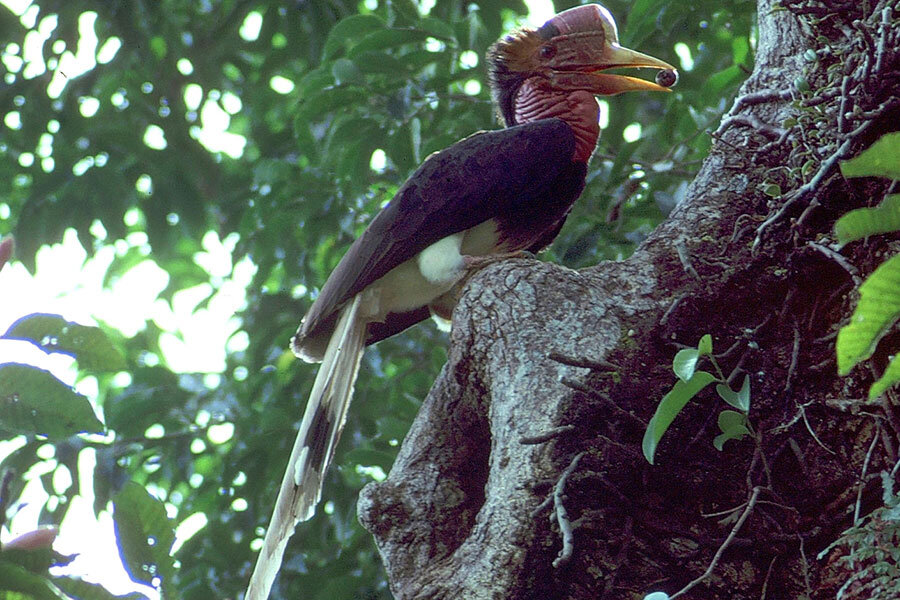Ivory on wings: Poachers threaten Southeast Asia's 'laughing' bird
Loading...
| JOHANNESBURG
Some call it "ivory on wings," part of the bill of a critically endangered bird in Southeast Asia that is sought by poachers and carved into ornaments for illegal sale to Chinese buyers.
The helmeted hornbill isn't getting as much attention as the beleaguered African elephant at a global wildlife conference this week in South Africa. But the killing of elephants by the tens of thousands for their tusks is intertwined with a surge in the slaughter of the rare bird whose beak part is a coveted substitute for ivory.
"It's all part of the rising demand for ivory," said Richard Thomas, spokesman for TRAFFIC, a conservation group based in Britain.
Poaching of the helmeted hornbill has soared since around 2010, particularly in Indonesia. The timing roughly coincides with an increase in elephant poaching that has caused a sharp drop in elephant populations. Last year, the helmeted hornbill was designated as critically endangered on an international "red list" of threatened species.
Delegates are discussing protections for elephants, helmeted hornbills, and other vulnerable wildlife at a meeting in Johannesburg of the Convention on International Trade in Endangered Species of Wild Fauna and Flora, or CITES. The 12-day meeting of the United Nations group, which regulates wildlife trade, ends Oct. 5.
The helmeted hornbill is a bird of lore, featuring in an ancient belief that it sits by a river between life and death. Its feathers have been used in traditional ceremonies. During breeding, the female is sealed into a nest, relying on the male to provide food.
The call of the helmeted hornbill is an intermittent, honking sound that slowly builds in tempo until it ends in what resembles, for some listeners, shrieks of laughter. Loud and long, the call helps poachers locate their prey.
In a CITES document, Indonesia asked for more collaboration among law enforcement agencies from countries where helmeted hornbills live, as well as "end market" nations – a reference primarily to China.
China, the world's main ivory consumer, has already said it plans to close its domestic ivory market.
A large lump on top of the beak of the helmeted hornbill is made of keratin, a protein also found in rhino horn and other animal and human parts. It has a red tinge and is softer than elephant ivory, making it an attractive material for carvers who have fashioned belt buckles, snuff boxes, pendants, and images of Chinese deities from it over many centuries.
The upper part of the bill, also known as a casque, is solid, unlike the hollow casques of other hornbill species. Its price on the illegal market is higher than that of elephant ivory. A casque weighs up to 350 grams (0.7 pounds); the average weight of an elephant tusk is five kilograms (11 pounds), though a big male's tusk can weigh 10 times as much.
While there are several varieties of hornbills, the helmeted hornbill is of particular interest to carvers because its casque is not completely hollow or spongy like its cousins, University of Sussex doctoral researcher Daniel J. Ingram explained in The Conversation in 2015:
This bird has a long history of being hunted by humans. Traditionally, the casque is harvested in low numbers for tribal medicine, for instance by the Orang Asli people in Malaysia where it is carved into rings and used to detect poison.
These days, by far the largest demand comes from China, where hornbill ivory can fetch up to five times as much as true ivory on the black market, costing around US$4-8 per gram, or up to US$1,000 for a single casque. Dating back to the Ming dynasty, the Chinese have used hornbill ivory to make decorative carvings and beads, which serve as luxury products to display wealth. It is also ground up and sold for traditional medicine. There is also a smaller trade in hornbill feathers, adding to the pressure on the species.
At least 2,170 heads and bill parts of helmeted hornbills were confiscated from the illegal trade in Indonesia and China between 2012 and 2014, TRAFFIC said.
Investigators found helmeted hornbill products being sold openly in Laos, a major transit point for wildlife traffickers that borders China, according to a TRAFFIC report released this month. Sale locations included a luxury hotel and convention center in central Vientiane, the capital, it said.
Indonesia said it has arrested more than 20 people in the helmeted hornbill trade and sentenced most of them. Penalties include up to five years in jail and a heavy fine.
On Saturday, rangers in Indonesia's Gunung Leuser National Park arrested a suspected helmeted hornbill poacher with a rifle and silencer, according to the Wildlife Conservation Society, or WCS, a group based in New York. The suspect had just entered the forest and did not have any bird parts.
"This species needs to be on people's radars," said Elizabeth Bennett, vice president of species conservation at WCS.
Illegal logging in Indonesia is shrinking the habitat of the helmeted hornbill. Conservationists fear poachers will focus on the Malaysian population once supply dries up in Indonesia.







